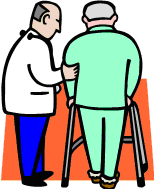| Home | About | Archives | RSS Feed |

The Independent Investor: Is There a Doctor in the House?
 |
A doctor shortage in America has been predicted ever since the first Baby Boomers started to retire. Now, that shortage is coming into question as technology and non-doctor, medical professionals are stepping forward to fill the gap.
The Association of American Medical Colleges predicts the nation will need 90,000 doctors by 2020 and 130,000 physicians by 2025. It is understandable how that organization arrived at that number. Just compute the proportion of Americans who will reach the age of 65 between now and 2030. Add to it the number of Americans newly insured, thanks to the Affordable Care Act, and you come pretty close to those numbers.
However, those figures simply represent the demand side of the equation assuming everything else remains the same. To be sure, there will still be a shortage of general practitioners, those front line physicians who are our first stop in accessing medical treatment and services. But a whole host of breakthroughs in medical knowledge, technology and treatment protocols are reducing not only the hours required to treat an aging population, but also the location of such treatment.
As a result, fewer patients visit hospitals today and when they do, their stay is reduced by a variety of outpatient choices. This pares down on the number of doctor visits each patient requires. In addition, many surgical procedures, thanks to advances in knowledge and technology, can be accomplished today through minimally invasive procedures that require less recovery time and therefore less doctor time.
Take my upcoming knee replacement, as an example. I have only seen my orthopedic surgeon once and will probably not see him again until the surgery. My hospital stay will be 2-3 days at the most, barring complications, and I'll most likely see him a week or so after the operation. That's it. Of course, in the meantime, I am seeing an army of technicians, physical therapists and so on.
This brings me to another sea change in medical treatment, the rise of the non-doctor primary care providers that include physician assistants, nurse practitioners, pharmacists and social workers. More often than not, you will find them working in teams. Think of the doctor’s assistant as the operations manager who, in my case, is sending me hither and yon to see various practitioners both before, during and after my operation.
In today's world you may never even see the doctor for some ailments. This year my GP suggested I see a dermatologist, (something I have avoided in the past). I have been back five times since that first visit and have never once seen the doctor. My skin ailments have been handled by a physician's assistant and a nurse practitioner. I'm sure the same thing is happening to you.
Training 130,000 doctors over the next decade requires an enormous amount of resources. In contrast, expanding medical practice law to allow nurses and pharmacists to provide more comprehensive primary care is a cheaper and a more time-efficient method to fill much of this potential doctor shortage. More emphasis on "team care" in our medical schools would also help leverage an underutilized medical work force that could do much, much more. Combined with the continued breakthroughs in medical technology and devices, we may just be able to keep up with the demand from people like me.
Bill Schmick is registered as an investment adviser representative with Berkshire Money Management. Bill’s forecasts and opinions are purely his own. None of the information presented here should be construed as an endorsement of BMM or a solicitation to become a client of BMM. Direct inquires to Bill at 1-888-232-6072 (toll free) or email him at Bill@afewdollarsmore.com.

